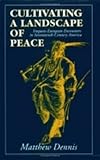Cultivating a Landscape of Peace : Iroquois-European Encounters in Seventeenth-Century America / Matthew Dennis.
Material type: TextPublisher: Ithaca, NY : Cornell University Press, [2018]Copyright date: ©1995Description: 1 online resource (336 p.) : 15 halftones. 6 mapsContent type:
TextPublisher: Ithaca, NY : Cornell University Press, [2018]Copyright date: ©1995Description: 1 online resource (336 p.) : 15 halftones. 6 mapsContent type: - 9781501723698
- 974.7/004975 23
- online - DeGruyter
| Item type | Current library | Call number | URL | Status | Notes | Barcode | |
|---|---|---|---|---|---|---|---|
 eBook
eBook
|
Biblioteca "Angelicum" Pont. Univ. S.Tommaso d'Aquino Nuvola online | online - DeGruyter (Browse shelf(Opens below)) | Online access | Not for loan (Accesso limitato) | Accesso per gli utenti autorizzati / Access for authorized users | (dgr)9781501723698 |
Frontmatter -- Contents -- Maps and Illustrations -- Acknowledgments -- Introduction -- PART I. LANDSCAPE, HISTORY, AND REPRESENTATION: THE CONSTRUCTION OF THE IROQUOIS -- 1. Iroquoia: Land, World View, and Landscape -- 2. Owasco into Iroquois: War, Peace, and the Social Construction of the Five Nations -- 3. Deganawidah and the Cultivation of Peace: Iroquois Ideology, Political Culture, and Representation -- PART II. NEW WORLDS -- 4. Settlement and Unsettlement: New Netherland, Beverwyck, and the Dutch Frontier -- 5. Commerce, Kinship, and the Transaction of Peace -- 6. False Starts and Failed Promises: New France and the French Frontier -- 7. Kinship, Conversion, Conquest, and the French-Iroquois Discourse of Frustration -- Epilogue: Iroquois Reconstruction -- Index
restricted access online access with authorization star
http://purl.org/coar/access_right/c_16ec
This book examines the peculiar new worlds of the Five Nations of the Iroquois, the Dutch, and the French, who shared cultural frontiers in seventeenth-century America. Viewing early America from the different perspectives of the diverse peoples who coexisted uneasily during the colonial encounter between Europeans and Indians, he explains a long-standing paradox: the apparent belligerence of the Five Nations, a people who saw themselves as promoters of universal peace.In a radically new interpretation of the Iroquois, Dennis argues that the Five Nations sought to incorporate their new European neighbors as kinspeople into their Longhouse, the physical symbolic embodiment of Iroquois domesticity and peace. He offers a close, original reading of the fundamental political myth of the Five Nations, the Deganawidah Epic, and situates it historically and ideologically in Iroquois life. Detailing the particular nature of Iroquois peace, he describes the Five Nations' diligent efforts to establish peace on their own terms and the frustrations and hostilities that stemmed from the fundamental contrast between Iroquois and European goals, expectations, and perceptions of human relationships.
Mode of access: Internet via World Wide Web.
In English.
Description based on online resource; title from PDF title page (publisher's Web site, viewed 26. Apr 2024)


